Bedell Cellars Winery Tour- What a way to spend a day!
Bedell Cellars is located at 36225 Main Road, Cutchogue, NY 11935.
U.S.A.. The we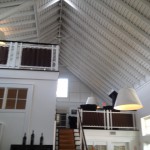 b site is www.wine@bedellcellars.com. It is located on the Long Island sound, surrounded by the Peconic bay off the Atlantic Ocean. The cellar boasts three (3) vineyards spanning seventy acres. Michael Lynne is the owner he is also a movie producer with a successful film production company. Lynne is also a trustee of the Museum of Modern Art in New York. Trent Preszler is the C.E.O. and has transformed Bedell Cellars over the last twelve (12) years, he is also a national leader in the farm winery movement. Rich Olsen- Harbich is the winemaker with over 30 years of experience. Dave Thompson is the vineyard manager and has been with the company since 1985.
b site is www.wine@bedellcellars.com. It is located on the Long Island sound, surrounded by the Peconic bay off the Atlantic Ocean. The cellar boasts three (3) vineyards spanning seventy acres. Michael Lynne is the owner he is also a movie producer with a successful film production company. Lynne is also a trustee of the Museum of Modern Art in New York. Trent Preszler is the C.E.O. and has transformed Bedell Cellars over the last twelve (12) years, he is also a national leader in the farm winery movement. Rich Olsen- Harbich is the winemaker with over 30 years of experience. Dave Thompson is the vineyard manager and has been with the company since 1985.
We left Harlem at 9:00 a.m. on a bleak Saturday morning in early May excited to experience our first winery tour and tasting. The drive was pleasant and when we arrived a little after 11:00 a.m. the sun was starting to c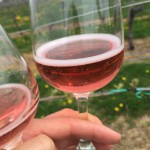 ome out although it was still a little chilly. We entered the potato barn that has been newly renovated (picture #1) where we were greeted with a glass of rosé seen in picture #2, which was a blend of cabernet sauvignon and merlot. It was crisp, refreshing and was $40 a bottle, well worth it, the balance between acidity and sugar was superb. We had reserved a private tour of the vineyard including a tour of the cellar and a wine tasting with cheese and crackers at a cost of $100.00 each.The only other option was $20.00 for a premium wine tasting so we decided to opt for the full experience and immerse ourselves in wine culture. Chris was our wine specialist who guided us through this very informative tour. Our first stop was the vines, bud breaks in the first week of May, they train small vines and their yields are 2-3 tons per acre. They aim for small yields and practice green harvesting which includes dropping fruit and pulling leaves by hand which aids in the reduction of mildew and rot. 95% of the grapes are harvested by hand. There are 150,000 vines with 8-10 people tending
ome out although it was still a little chilly. We entered the potato barn that has been newly renovated (picture #1) where we were greeted with a glass of rosé seen in picture #2, which was a blend of cabernet sauvignon and merlot. It was crisp, refreshing and was $40 a bottle, well worth it, the balance between acidity and sugar was superb. We had reserved a private tour of the vineyard including a tour of the cellar and a wine tasting with cheese and crackers at a cost of $100.00 each.The only other option was $20.00 for a premium wine tasting so we decided to opt for the full experience and immerse ourselves in wine culture. Chris was our wine specialist who guided us through this very informative tour. Our first stop was the vines, bud breaks in the first week of May, they train small vines and their yields are 2-3 tons per acre. They aim for small yields and practice green harvesting which includes dropping fruit and pulling leaves by hand which aids in the reduction of mildew and rot. 95% of the grapes are harvested by hand. There are 150,000 vines with 8-10 people tending  the vineyard each touching the vine 8-10 times per year. This equals to over 1 million hands-on interactions with the vines for the year. Vines are self-pollinating. The oldest vines were planted in 1980, the chardonnay grape is among them, and it is 35 years old, the oldest vine on the North Folk coast. Viogner was planted in 1994. Bedell Cellars grow 15 grape varieties including chardonnay and chardonnay clones, sauvignon blanc, cabernet franc, Albariño, merlot, malbec, gewürztraminer, viognier and syrah. Plants are given a little less water than is needed so that it competes to ripen the grape which will add more complexity to the wine. 2009 was an exceptional vintage for merlot and was enjoyed at the White House by President Obama and the First Lady at a major Presidential function, the only vineyard to boast such an honor. Clones of chardonnay are widely grown here they have an earlier ripening period and are more disease resistant. The southern side of the vineyard has more exposure to sun and has
the vineyard each touching the vine 8-10 times per year. This equals to over 1 million hands-on interactions with the vines for the year. Vines are self-pollinating. The oldest vines were planted in 1980, the chardonnay grape is among them, and it is 35 years old, the oldest vine on the North Folk coast. Viogner was planted in 1994. Bedell Cellars grow 15 grape varieties including chardonnay and chardonnay clones, sauvignon blanc, cabernet franc, Albariño, merlot, malbec, gewürztraminer, viognier and syrah. Plants are given a little less water than is needed so that it competes to ripen the grape which will add more complexity to the wine. 2009 was an exceptional vintage for merlot and was enjoyed at the White House by President Obama and the First Lady at a major Presidential function, the only vineyard to boast such an honor. Clones of chardonnay are widely grown here they have an earlier ripening period and are more disease resistant. The southern side of the vineyard has more exposure to sun and has 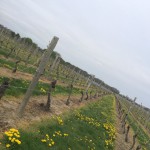 a later ripening period, grapes like cabernet sauvignon and petit verdot are planted here, syrah needs the most sunlight and is planted on the southernmost tip of the vineyard. The back of the vineyard is due north and chardonnay and its clones mature here. Cutchogue is said to have the most sunlight and u.v. light in the whole of New York, although I could not find any information to support that. Vines are planted by clippings not seeds which are placed in a nursery for one (1) year before being planted and are grown two (2) years before they are trained on a trellis system. Bedell Cellars practice the guidelines of the Long Island sustainable wine growing (LISW) association which consist of over 200 farming practices and regulations and was formulated by Cornell University. A third party inspects the vineyard and if it has practiced sustainable wine habits a seal of approval is given by the LISW. Bedell Cellars practice integrated pest management (IMP), they use minimum nitrates and peanut meal is used instead to retard the formation of bacteria. They keep the cover crop dense which prevents erosion and promotes the natural predators. If chemical sprays have to be used toxins are minimal and do not show up in ground water.
a later ripening period, grapes like cabernet sauvignon and petit verdot are planted here, syrah needs the most sunlight and is planted on the southernmost tip of the vineyard. The back of the vineyard is due north and chardonnay and its clones mature here. Cutchogue is said to have the most sunlight and u.v. light in the whole of New York, although I could not find any information to support that. Vines are planted by clippings not seeds which are placed in a nursery for one (1) year before being planted and are grown two (2) years before they are trained on a trellis system. Bedell Cellars practice the guidelines of the Long Island sustainable wine growing (LISW) association which consist of over 200 farming practices and regulations and was formulated by Cornell University. A third party inspects the vineyard and if it has practiced sustainable wine habits a seal of approval is given by the LISW. Bedell Cellars practice integrated pest management (IMP), they use minimum nitrates and peanut meal is used instead to retard the formation of bacteria. They keep the cover crop dense which prevents erosion and promotes the natural predators. If chemical sprays have to be used toxins are minimal and do not show up in ground water.
Terroir:
The P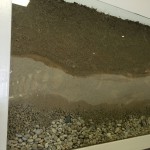 econic bay helps to moderate temperatures
econic bay helps to moderate temperatures
which do not fall below 0°f or rise above 90°f. It has a maritime climate with cool moderate conditions and heavy rainfall, due to the Atlantic Ocean. There is a long growing season around 200 days which provides the grapes with a slow ripening process and provides more time for harvest. The area is non- irrigated and there is excellent drainage due to the soil composition. The newer vines have a drip system of irrigation in place. The older plants are low-impact, roots can reach the water table just below. The soil is Newhaven loam which is a sandy base, with gravel some silt and clay. According to “Exploring Wine” by Kolpan, Smith and Weiss loam “is crumbly and has better drainage than clay”. The top soil is plant material the sub-soil is silt, clay and sand and the parent material are components of a glacier and volcanic sediment.
Fermentation:
Red wines are fermented in oak barrels and stainless steel vats. The older o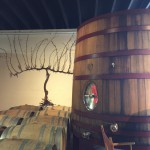 ak casks are preferred as it offers a more neutral flavor with more fruit forward notes. Cooper oak barrels are used, they are said to be the best and cost $1200. 00 each for the large barrel which holds 59 gallons or approximately 225 liters. When fermented in stainless steel tanks small tanks are used and there is less contact with the sediment there is also no oak flavor. Head space is left at a minimum and tanks are kept as full as possible constantly being topped up once a week with wine, this prevents oxidation and spoilage. If oxidation is a threat an inert gas, nitrogen may be added to prevent it. Red fruit is destemmed, hand sorted to remove rocks, stems and all MOG’s- matter other than grape. Instead of pumping red must, which is the more traditional way, it is dumped from the top of a 1700 gallon stainless steel tank by a grape elevator and gravity takes care of the rest, this method is called a “pump over”.
ak casks are preferred as it offers a more neutral flavor with more fruit forward notes. Cooper oak barrels are used, they are said to be the best and cost $1200. 00 each for the large barrel which holds 59 gallons or approximately 225 liters. When fermented in stainless steel tanks small tanks are used and there is less contact with the sediment there is also no oak flavor. Head space is left at a minimum and tanks are kept as full as possible constantly being topped up once a week with wine, this prevents oxidation and spoilage. If oxidation is a threat an inert gas, nitrogen may be added to prevent it. Red fruit is destemmed, hand sorted to remove rocks, stems and all MOG’s- matter other than grape. Instead of pumping red must, which is the more traditional way, it is dumped from the top of a 1700 gallon stainless steel tank by a grape elevator and gravity takes care of the rest, this method is called a “pump over”.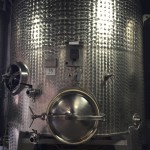
Stainless steel is used for holding tanks for fermentation. Racking is done a few times during the course of the red wine aging process. Tannins are managed in a number of ways, carbon dioxide is added to the tank which causes the solid matter to rise to the top such as grape skins. Free run juice is pumped from the bottom over the grape skins and juice is aerated which prevents bacterial spoilage and creates color. Sometimes the residue is redistributed manually. Commercial yeast is not used during the fermentation process, only wild naturally occurring indigenous yeast is used. This natural fermentation takes 2-4 weeks.
Bottli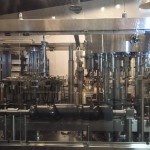 ng is fully automated and up to 1200 cases can be bottled in a day. The system is sanitized with nitrogen and natural cork is used which leaves less of a carbon footprint. All labeling is done by machine for both front and back labels. The base of the majority of wines at Bedell Cellars are the early press chardonnay and sauvignon blanc varieties.
ng is fully automated and up to 1200 cases can be bottled in a day. The system is sanitized with nitrogen and natural cork is used which leaves less of a carbon footprint. All labeling is done by machine for both front and back labels. The base of the majority of wines at Bedell Cellars are the early press chardonnay and sauvignon blanc varieties.
Tradition:
Every season employees add fruits, vegetables and flowers to the yeast starter culture as a tribute to the season for prosperity and good
season employees add fruits, vegetables and flowers to the yeast starter culture as a tribute to the season for prosperity and good
Tasting Notes
The tasting menu we received was the premium flight, we were 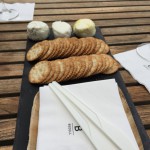 served three different kinds of goat cheese and crackers. The goat cheese was from Catapano local farms and was lemon pepper, chevre and parsley and basil. A metal spittoon was also pro
served three different kinds of goat cheese and crackers. The goat cheese was from Catapano local farms and was lemon pepper, chevre and parsley and basil. A metal spittoon was also pro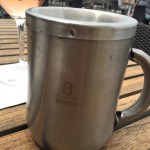 vided.
vided.
Most wines have celebrity art work on their labels due to Michael Lynne’s passion for the arts. The merlot which is one of their signature grapes only has the Bidell wine label with no artist highlighted on the bottle.
1. Dry Ro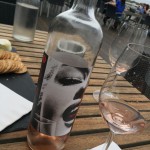 sé- 2014. $25.00 a bottle. The design on the bottle is from the artist Barbara Kruger who produces many black and white photographs overlaid with declarative captions. The color of the wine is clear with a slight touch of peach, on the nose is grapefruit and apricot. The wine has a light finish, is dry and slightly acidic on the palate with tropical notes. It would be excellent with a seafood salad with a fruit vinaigrette. We were excited for the rosé but this was not even close to the complexity and flavor of the first sparkling rosé we tried upon our arrival.
sé- 2014. $25.00 a bottle. The design on the bottle is from the artist Barbara Kruger who produces many black and white photographs overlaid with declarative captions. The color of the wine is clear with a slight touch of peach, on the nose is grapefruit and apricot. The wine has a light finish, is dry and slightly acidic on the palate with tropical notes. It would be excellent with a seafood salad with a fruit vinaigrette. We were excited for the rosé but this was not even close to the complexity and flavor of the first sparkling rosé we tried upon our arrival.
2. Gewürztraminer- 2013. $40.00 a bottle. This grape is 33 years old. The wine is dry with low residual sugar with great consistency and complexity. Howard Schatz is the artist featured on this bottle he photographed a calla lily. Chris our host, describes the wine as spicy with floral aromatics, rose petals and lychee notes with a salinity due to the sea breeze. The color is pale yellow with an odd smell on the nose, I was amiss, maybe petroleum but not quite, vaseline or some other chemical? The only term I could muster was “funky”. The smell was so overwhelming for me it consumed the palette, it was displeasing and highly disappointing. I asked Chris to check the wine and he reported that the bottle was not compromised.
Gewürztraminer- 2013. $40.00 a bottle. This grape is 33 years old. The wine is dry with low residual sugar with great consistency and complexity. Howard Schatz is the artist featured on this bottle he photographed a calla lily. Chris our host, describes the wine as spicy with floral aromatics, rose petals and lychee notes with a salinity due to the sea breeze. The color is pale yellow with an odd smell on the nose, I was amiss, maybe petroleum but not quite, vaseline or some other chemical? The only term I could muster was “funky”. The smell was so overwhelming for me it consumed the palette, it was displeasing and highly disappointing. I asked Chris to check the wine and he reported that the bottle was not compromised.
3. Gallery- 20 13 $60.00 a bottle. This is a blend which includes 70% Dijon chardonnay (a clone) 24% viognier 6% sauvignon blanc. This wine is fermented in stainless steel tanks and then oak aged after blending. This ensures some acidity and keeps the ripeness and fullness of the wine intact. Ross Bleckner is the artist who designed this label his photograph is of falling birds. This wine undergoes malolactic fermentation to change malic acid to lactic acid which is smoother and creamier. The wine is very pale with a citrus and buttery nose and a fruit forward mild oak palette and an excellent finish. This wine was by far my favorite. I have never tried wine like this before. I wish I had the money to buy a bottle but I did not so I did the next best thing and had a glass after the tasting was done. Delicious!!!
13 $60.00 a bottle. This is a blend which includes 70% Dijon chardonnay (a clone) 24% viognier 6% sauvignon blanc. This wine is fermented in stainless steel tanks and then oak aged after blending. This ensures some acidity and keeps the ripeness and fullness of the wine intact. Ross Bleckner is the artist who designed this label his photograph is of falling birds. This wine undergoes malolactic fermentation to change malic acid to lactic acid which is smoother and creamier. The wine is very pale with a citrus and buttery nose and a fruit forward mild oak palette and an excellent finish. This wine was by far my favorite. I have never tried wine like this before. I wish I had the money to buy a bottle but I did not so I did the next best thing and had a glass after the tasting was done. Delicious!!!
4. Malbec- 2013. $50.00 a bottle. 12-13% A.B.V. Grown in this cool climate it is acidic, it is estat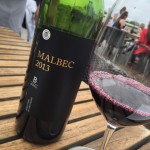 e labeled. It typically has aromatic and spicy notes. 2013 was an excellent year for Malbec and it shows. The color is beautiful and rich, magenta ruby colored. Hints of cloves, dried currants and dried cherries on the nose. The palette enlivens with vanilla, clove and dried fruit flavors. It is medium bodied with medium tannins and can be aged up to 10 years after vintage date. Very delicious but again out of my price range
e labeled. It typically has aromatic and spicy notes. 2013 was an excellent year for Malbec and it shows. The color is beautiful and rich, magenta ruby colored. Hints of cloves, dried currants and dried cherries on the nose. The palette enlivens with vanilla, clove and dried fruit flavors. It is medium bodied with medium tannins and can be aged up to 10 years after vintage date. Very delicious but again out of my price range
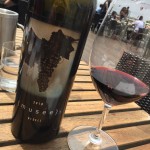
5. Musee- 2012. $90.00 a bottle. Chuck Close did the stencil photography, he is paralyzed and has a slight mental handicap and is known for his large portraits, his paint brushes are hooked up to a pulley system. This wine is a blend of 65% merlot 30% cabernet sauvignon some petit verdot and syrah are also in the blend. Cabernet sauvignon is a difficult grape to grow in this region but 2010 was an excellent year, it was the best year since 1973 when the first vines were planted.
This was an unforgettable experience. I will be doing this again many more times in my life. What makes it even greater is that the tastings are affordable $15-$20 and you can bring snacks and sit out doors and enjoy the sunshine and sip on wine. What was great about the tour is that we knew all the wine terminology and were able to ask specific industry questions because we study wine. That felt great. I learned one thing priming/ charging/ rincing is better done with the wine you are about to taste and not water. Water can leave behind chlorine or other chemicals that influence the taste of the wine. Bedell Cellars harvest all the way to late October I would like to visit again in a couple months to see the grapes on the vines.
References
Wine Spectator Home | Wine Spectator. (n.d.). Retrieved May 14, 2015, from http://www.winespectator.com/
Kolpan, S., & Smith, B. (1996). The right stuff: Grape growing and grape types. In Exploring wine: The Culinary Institute of America’s complete guide to wines of the world (3rd ed., p. 7). New York: Van Nostrand Reinhold.
Certified Trained Employee of Bidell Wine Cellars – Chris.



